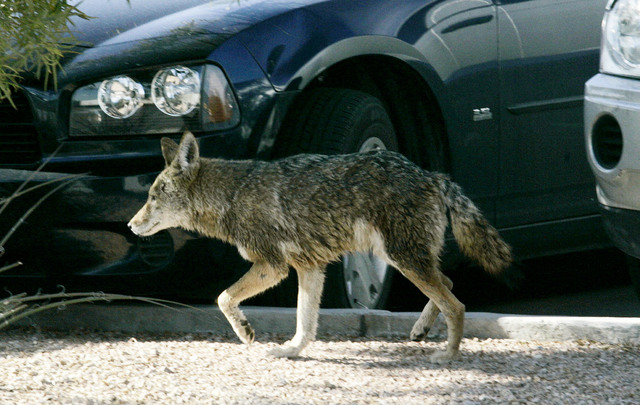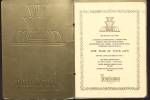Small pets around valley can be a target for coyotes
Coyotes have been in Southern Nevada longer than people and are part of the natural environment, but that can be difficult to put into perspective when they’re in your backyard with your beloved pet in their jaws.
“We had an incident a few years ago in Desert Inn Mobile Estates where a woman was walking her little dog, and a coyote snatched it up and ran off with it, leash and all,” said Nevada state Sen. Mark Manendo. “Usually, it’s more of an issue at night, but this was in broad daylight.”
As the valley developed, many of the same amenities that attract people have attracted coyotes, and people and their pets have come into conflict with one another more frequently as both populations have increased.
“The way we’ve developed Las Vegas, especially golf course communities, with plenty of water features and green grass, has provided food, water and shelter for squirrels, rabbits, mice and birds,” said Doug Nielsen, a conservation educator for the Nevada Department of Wildlife. “All of those are prey for the coyote. Add fruit trees and that’s just like the cherry on top.”
Nielsen added that the statewide drought has eliminated some of the animals in the desert environment.
“It’s only natural that they would come into town for a meal,” Nielsen said. “They don’t differentiate between a wild rabbit and a domestic cat. It’s all food to them.”
The problem is further complicated by the city’s growth to the edges of the desert wilderness and the presence of cats and small dogs, which are easy prey for coyotes. Many a suburbanite has left their pug or tabby in their backyard alone for a few minutes only to discover how ineffective a barrier a 6-foot fence is to a coyote.
The Nevada Department of Wildlife has hosted town hall meetings and presentations at homeowners associations to educate the public on how to keep pets safe from coyotes, but sometimes attendees are unwilling to act.
“First and foremost, the No. 1 thing to do to not attract coyotes is don’t feed them,” Nielsen said. “At almost every presentation, a person comes up to us afterward and tells us they understand, but they can’t bear to see them without feeding them.”
Feeding coyotes can be intentional, such as tossing an extra burger over the fence, or accidental, such as leaving food in the backyard for pets. Coyotes will also find food in trash, so it’s important to cover trash cans with a well-fitting lid.
Nielsen also tells people to follow the leash laws and keep their pets close at all times when they’re outside. He’s not a fan of retractable leashes, which can leave a pet farther away from its owner than is safe. Little dogs in particular shouldn’t be let out into the yard alone, especially at dawn or dusk, prime hunting time for coyotes.
For several reasons, including keeping them safe from coyotes, cats shouldn’t be allowed to wander the neighborhood.
“There’s a philosophy among some cat owners that they have to be able to run around and roam the neighborhood to be happy cats,” Nielsen said. “I’m not going to argue that one way or another, but if you let your cat wander in an area where coyotes are prevalent, one night, that cat’s not going to come home. You’re painting a bull’s-eye on its back.”
Nielsen also tells people to make coyotes uncomfortable when they see the animals, such as by yelling and making loud noise. If appropriate, carry an airhorn to startle them. If you have the opportunity, spray them with a garden hose, Nielsen said. The idea is to make it an unpleasant place for the coyote, but make sure the animal has room to escape. Any cornered wild animal is dangerous.
Science has come up with one possible solution, but it has met with some resistance in the valley by some homeowners associations. Coyote rollers are rolling tubes that can be mounted on the top of walls. Coyotes can jump 5 or 6 feet, but generally, to get over a 6-foot wall, they need to catch the top of the wall with their front paws and push off and over. The coyote rollers, which are sold in 4-foot lengths for about $30, are aimed at preventing this.
“We’ve gotten some resistance from some HOAs,” Manendo said. “They cite things that I don’t think are real issues, like people putting up bright yellow and red rollers or something else that doesn’t look right. I think that’s easy to correct with specific language while still allowing the installation of coyote rollers.”
Manendo is sponsoring a Senate bill that directly addresses coyote rollers, also known as fence rollers. The bill recently was heard in committee, and Manendo feels it has a good chance of passing the Legislature this session.
“I feel confident, based on the reaction of the committee members,” he said. “More than half made comments or seemed favorable toward it. We had a similar issue a few years ago concerning rolling shutters, and that took a bill to get them passed through HOAs statewide.”
Not living on the edge of town or in a golf course community doesn’t ensure your pets’ safety from coyotes. Nielsen said the valley’s washes are virtual highways for wildlife and that he’s aware of some coyotes that have lived for generations in the valley.
Manendo lives on the east side of the valley near several golf courses, washes and the Clark County Wetlands Park and has never encountered a coyote, but neighbors from less than a mile away have lost their pets to coyotes, he said.
“I’ve been contacted about coyotes and coyote rollers by people all over the valley,” Manendo said. “I could see the rollers not only keeping coyotes out but keeping dogs in and making walls more difficult for intruders to climb.”
For more information, visit tinyurl.com/nevadacoyotes or tinyurl.com/nvsenatebill221.
To reach East Valley View reporter F. Andrew Taylor, email ataylor@viewnews.com or call 702-380-4532.




























